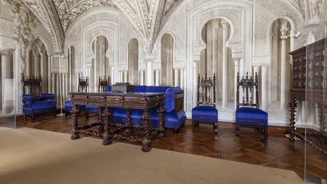National Palace of Pena recovers the original decoration of the Sitting Room
27 Jan 2023
After seven years of research, the National Palace of Pena team has managed to reconstruct the original decoration of the Sitting Room and recover the atmosphere conceived by King Ferdinand II in the 19th century. The research revealed that, in the most protocol-bound room of the Palace, where visitors were received, the monarch made a strong investment in luxurious, elegant and sophisticated decorations to impress those received there. Between mural paintings, furniture, bronzes, porcelain and velvet, where "gold on blue" stood out, everything contributed to this sumptuous appearance. It was found that most of the pieces that made up the room in the 19th century were still in the Palace. With this museum project, they have now returned to where they were placed by King Ferdinand II. The blue velvet textiles have also returned, rigorously reconstituted with the aim of providing today's visitors with an experience similar to that of visitors from the past.
In order to understand what the Sitting Room of Ferdinand II – the king who ordered the construction of the Palace of Pena – looked like, it was necessary to study the monument's historical inventories, its collection, and the invoices of the monarch's purchases for interior decoration. The team of researchers also discovered a precious stereoscopic image taken by Carlos Relvas, which depicts this room in the early 1870s. These sources reveal that, in addition to the ornamentation of the walls and ceiling with a trompe l'oeil mural painting alluding to Islamic architecture, which Ferdinand II commissioned from Paolo Pizzi in 1854, the decoration of the space was also the object of special care on the part of the king.
In terms of furniture, the preference was for sinuous turned pieces in rosewood of national production from the 17th and 18th centuries, which Ferdinand II greatly appreciated. Such furniture is exemplified by the desk, the chest of drawers, and the buffet that feature in the room. On top of them, the king placed high-quality decorative objects such as the pair of French bronze and blue porcelain lamps and several pieces of oriental porcelain from his collection. The setting is completed by textiles in luxurious materials, such as velvets and silk trimmings, which envelop the space and give it the intended formality and appearance. The reconstruction of the textile elements was both the starting point and the greatest challenge of this museum project.
"Gold on blue" to impress the senses
Based on an invoice from the Barbosa e Costa house, it was discovered that blue velvet was the fabric ordered by King Ferdinand II to be applied to the upholstery of the canapé and chairs and on the frame of the stove in this room. The pacific blue shade described in the documents studied is in complete harmony with the blue porcelain lamps and bowl mounted in bronze that were in the Sitting Room at that time. These sources also reveal that the fabric was applied to the upholstery and frames with gilt nails. It was thus possible to faithfully reconstruct the upholstery of the canapé and six chairs, as well as the frame of the stove, achieving a sophisticated and elegant "gold on blue" effect that impresses the senses.
The design of this room is directly linked to its function. Together with the Green Room and the Sacristy Hall, the Sitting Room formed part of the most public area of the Palace. The daily visitors of Ferdinand II and the Countess of Edla would enter through the door of the Sacristy Hall and wait in the Green Room, where the book where they could sign their names was located. Visitors were then received "standing" in the Sitting Room, with only some invited to access the more private areas of the palace, depending on the degree of proximity to the monarch and the Countess of Edla, the subject to be dealt with, or the cause of the visit.
The museum project will be completed this year with the installation of some pieces of furniture, which will be restored, and the installation of blue velvet curtains.

